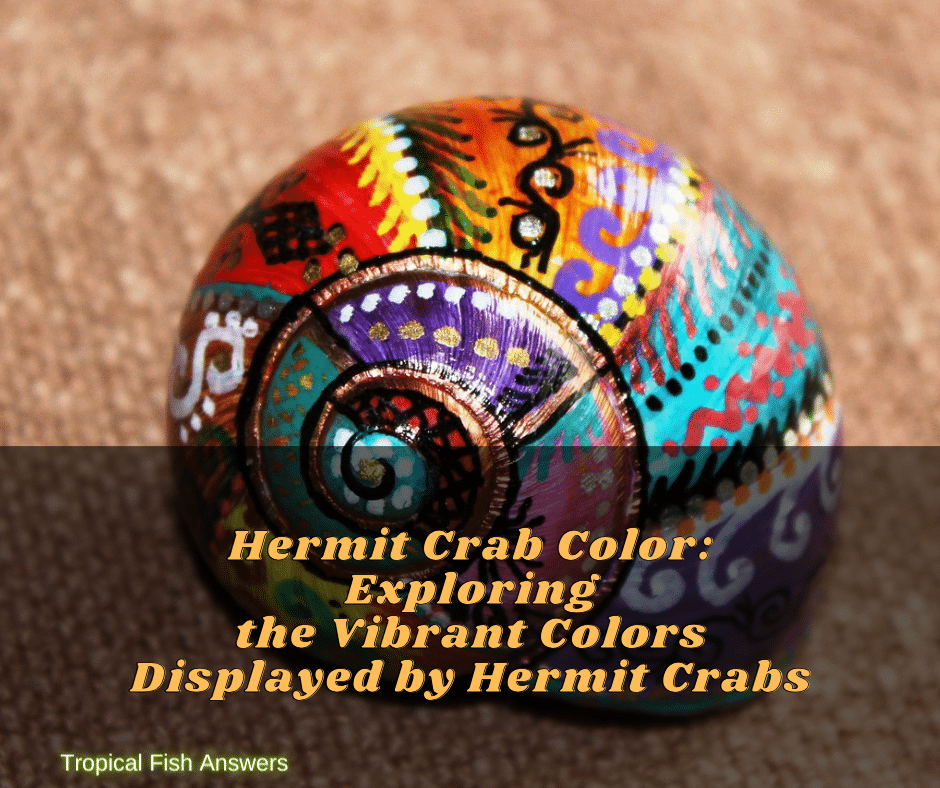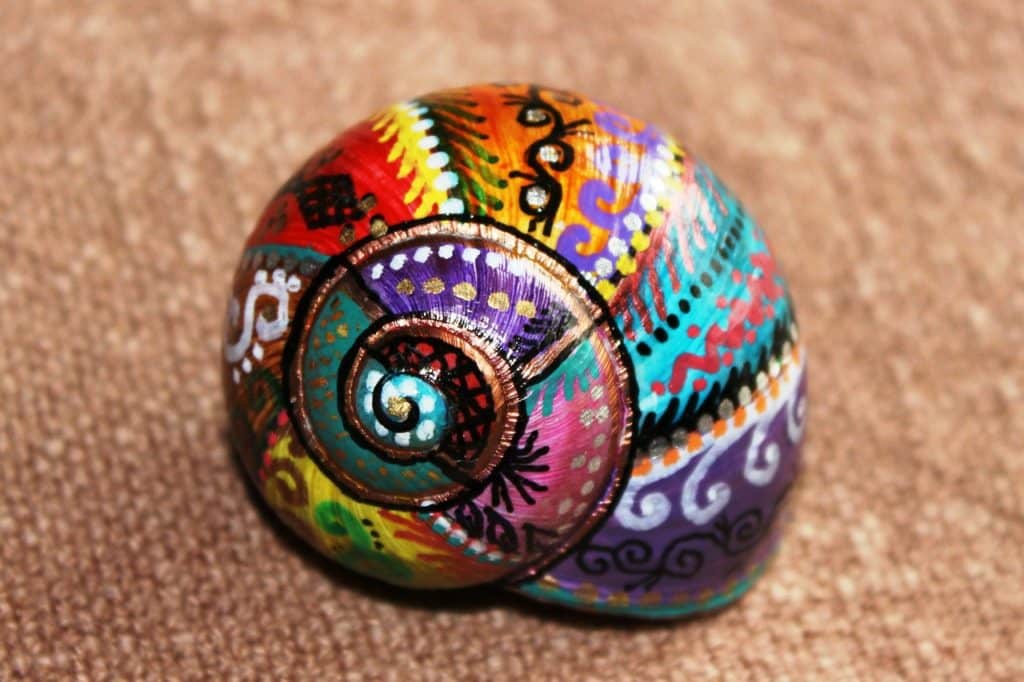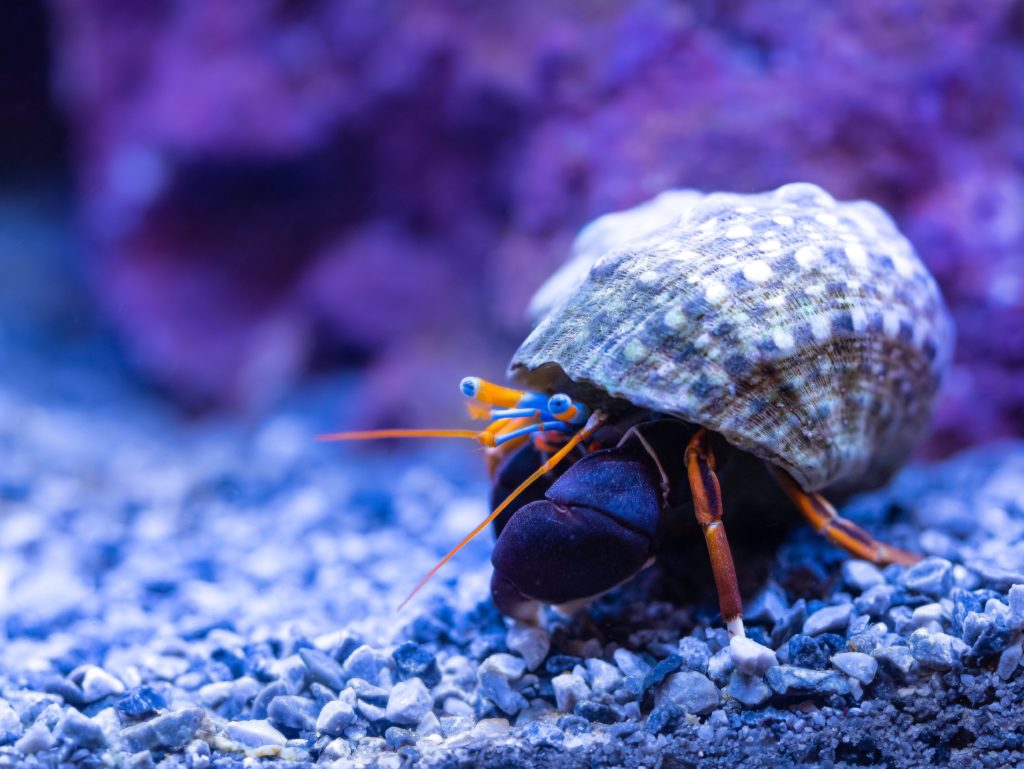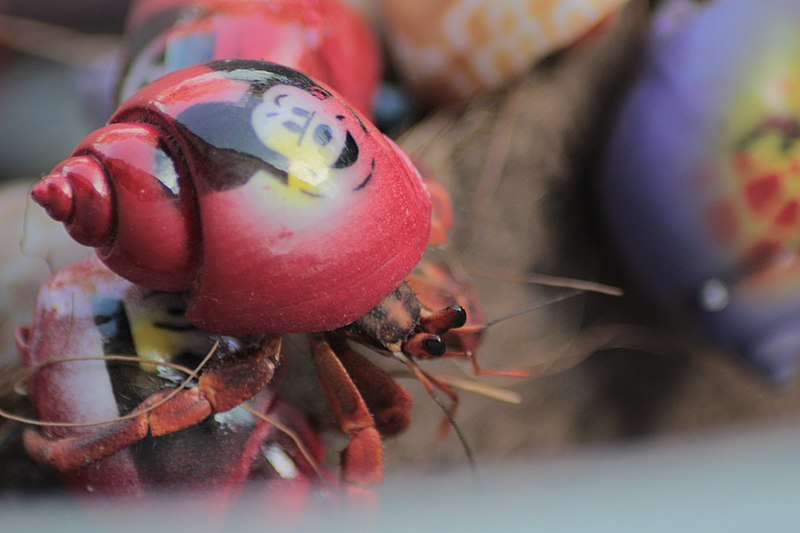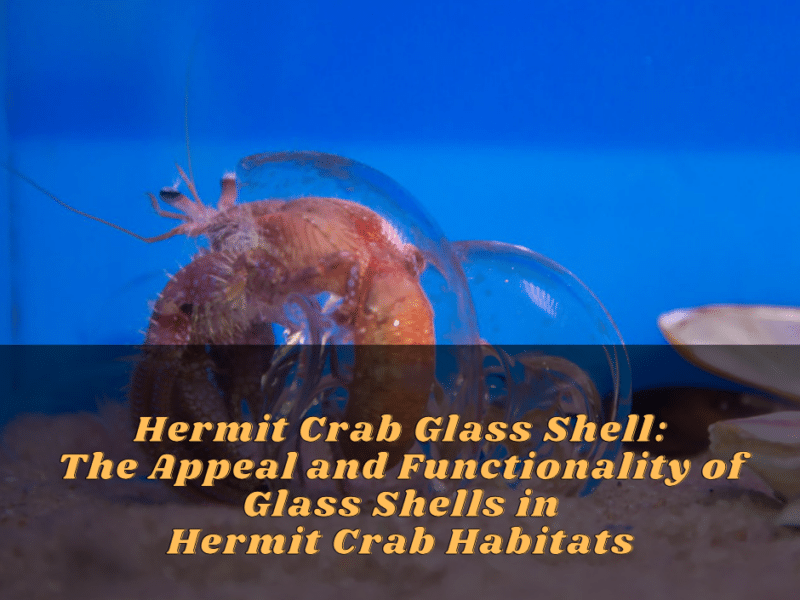Introduction
Introduction to Hermit Crab Color and their significance in nature
Hermit crabs are fascinating creatures that have the ability to change their coloration through the choice of shells they inhabit. While their bodies are mostly hidden within the shells, except for their eyes and parts of their legs, these crabs can still modify their appearance over short periods of time. However, it is important to note that hermit crabs have a limited perception of their own coloration due to possessing only a single spectral class of photoreceptor.
Hermit Crab Color in relation to survival and communication
The ability to change coloration in hermit crabs is believed to have survival benefits. By selecting shells that closely match the surrounding environment, these crabs can effectively blend in and avoid predators. The choice of shell color and patterning may help camouflage the crabs and provide them with a better chance of survival in their natural habitats.
In addition to camouflage, coloration in hermit crabs may also play a role in communication. While their own perception of color may be limited, the shell color and patterns can still convey important information to other crabs. This visual communication could help establish dominance, attract mates, or signal readiness for reproduction.
It is important to further explore the mechanisms behind hermit crab coloration and its significance in their natural habitats. Research could focus on understanding how environmental factors influence coloration choices, the potential impact on mating behavior, and the role of color in species recognition.
Overall, the ability of hermit crabs to change their coloration through shell choice showcases their incredible adaptability and survival strategies. Further studies in this area could provide valuable insights into the intricate dynamics of coloration and communication in these fascinating creatures.
Melanin Pigmentation in Hermit Crabs
Exploring the role of melanin in coloring hermit crabs’ exoskeleton
Melanin, a pigment responsible for coloration in many animals, plays a significant role in coloring the exoskeleton of hermit crabs. The amount and distribution of melanin determine the coloration and patterns observed in these creatures. Through the regulation of melanin production and distribution, hermit crabs can adapt their coloration to match their surroundings.
Variations in melanin pigmentation among different hermit crab species
Different species of hermit crabs possess varying levels of melanin pigmentation, resulting in a wide range of colors and patterns. Some species may have darker or lighter exoskeletons, depending on the amount and distribution of melanin in their cells. Environmental factors, such as exposure to sunlight and availability of food, may also influence melanin production and contribute to differences in coloration among species.
Further research is needed to understand the specific mechanisms behind melanin pigmentation in hermit crabs. By studying the genetic and environmental factors that influence melanin production, scientists can gain insights into how these crabs adapt to their surroundings and communicate with each other.
In conclusion, melanin pigmentation plays a crucial role in coloring the exoskeleton of hermit crabs. The ability to adapt their coloration through melanin production allows these creatures to blend in with their environment and potentially communicate with other crabs. Further research in this field will provide a better understanding of how coloration contributes to the survival and behavior of hermit crabs.
Carotenoid Pigmentation in Hermit Crabs
Understanding the impact of carotenoids on hermit crab coloration
Carotenoids, a group of pigments found in fruits and vegetables, have been shown to significantly impact the coloration of hermit crabs’ exoskeleton. These pigments are responsible for the vibrant and vivid hues observed in certain species of crabs. The consumption of carotenoid-rich foods can lead to a change in the intensity and tone of the crab’s color, making it a key factor in their overall appearance.
Sources of carotenoids in hermit crab diet and their effects on coloration
Carotenoids can be obtained through the consumption of various fruits and vegetables that are bright in color. Foods such as carrots and marigold petals have been known to enhance the orange hues in hermit crabs. These carotenoid-rich foods contain compounds such as beta-carotene, which can be metabolized by the crab’s body and deposited in its exoskeleton, resulting in a more vibrant coloration.
It is important to note that the impact of carotenoids on hermit crab coloration may vary depending on the species and individual crab. Some crabs may have a genetic predisposition to absorb and utilize carotenoids more effectively, resulting in a more pronounced color change. Environmental factors, such as exposure to sunlight, can also influence the absorption and expression of carotenoid pigmentation in hermit crabs.
Further research is needed to fully understand the mechanisms behind carotenoid pigmentation in hermit crabs and its role in their overall health and survival. By studying the genetic and environmental factors that influence the uptake and utilization of carotenoids, scientists can gain valuable insights into the evolutionary significance of coloration in these fascinating creatures.
In conclusion, carotenoids play a significant role in the coloration of hermit crabs. The consumption of carotenoid-rich foods can lead to a change in their exoskeleton color, resulting in more vibrant and visually striking hues. Understanding the impact of carotenoids on hermit crab coloration allows us to appreciate the intricate relationship between diet, genetics, and environmental factors in shaping the appearance of these fascinating creatures.
Structural Coloration in Hermit Crabs
Examining the optical properties of hermit crabs’ exoskeleton
The exoskeleton of hermit crabs plays a crucial role in their coloration and visual appearance. Unlike carotenoid pigmentation, which is influenced by the consumption of certain foods, structural coloration is determined by the physical properties of the exoskeleton itself. The exoskeleton of hermit crabs contains microscopic structures that interact with light, producing vibrant and iridescent colors.The optical properties of the exoskeleton can vary depending on the arrangement and shape of these microscopic structures. By studying the structure-function relationship, scientists can gain insights into how hermit crabs achieve their unique coloration and camouflage techniques.
The role of structural coloration in creating vibrant colors
Structural coloration is responsible for the striking and vivid hues observed in certain species of hermit crabs. The microscopic structures in the exoskeleton act as miniature prisms that diffract light, resulting in a range of colors that can appear metallic or iridescent. This phenomenon, known as structural coloration, is responsible for the vibrant blue, green, and purple shades seen in some hermit crab species.Compared to carotenoid pigmentation, which relies on specific dietary factors, structural coloration is a more direct and inherent feature of the crab’s exoskeleton. The precise arrangement and organization of the microscopic structures contribute to the complexity and diversity of color patterns observed in hermit crabs.Further research is needed to fully understand the mechanisms behind structural coloration in hermit crabs. By studying the optical properties of their exoskeleton, scientists can gain a deeper appreciation for the intricate structural adaptations that these creatures have developed for survival and communication.In conclusion, structural coloration is a fascinating aspect of hermit crab biology that contributes to their vibrant and visually striking appearance. Unlike carotenoid pigmentation, structural coloration is an inherent characteristic of the exoskeleton itself, determined by the arrangement and shape of microscopic structures. Through ongoing research, scientists are unraveling the mechanisms behind this phenomenon and gaining a better understanding of the evolution and functional significance of coloration in hermit crabs.
Environmental Factors Affecting Hermit Crab Color
How environmental factors such as temperature and light influence hermit crab coloration
The coloration of hermit crabs can be influenced by various environmental factors, including temperature and light. These factors can affect the functioning of pigment cells and the overall appearance of the crab’s exoskeleton.
Temperature: The temperature of the surrounding environment can impact the intensity and range of colors displayed by hermit crabs. Warmer temperatures may enhance the pigmentation and make the colors appear more vibrant, while cooler temperatures may result in a duller or faded appearance.
Light: The availability and quality of light can also influence hermit crab coloration. Different wavelengths of light can be absorbed or reflected by the exoskeleton, resulting in different colors being displayed. For example, in certain light conditions, hermit crabs with iridescent exoskeletons may appear more vivid and eye-catching.
Adaptation of hermit crabs to their specific habitat through color changes
Hermit crabs have a remarkable ability to change their coloration as an adaptation to their specific habitat. This adaptation allows them to blend in with their surroundings, providing camouflage for protection against predators or enhancing their ability to stealthily search for food.
Crypticity: In heterogeneous environments, hermit crabs can rapidly adjust their external coloration to match their surroundings, aiding in their camouflage and crypticity. This rapid color change is driven by physiological mechanisms within the crab’s body.
Immediate threats: However, the ability of hermit crabs to change color may be inhibited when they are faced with immediate threats, such as predation. In such situations, the crabs may prioritize evasive behaviors over color change, prioritizing their survival rather than maintaining crypticity.
In conclusion, environmental factors such as temperature and light play a significant role in influencing the coloration of hermit crabs. The ability of these creatures to adapt their coloration to their specific habitat allows them to enhance their chances of survival by blending in with their surroundings. Understanding the impact of environmental factors on hermit crab color can provide valuable insights into their ecology and behavior.
Color Changes during Growth and Maturity
Investigating the color changes hermit crabs undergo during the molting process
The molting process in hermit crabs is closely associated with changes in coloration. As hermit crabs grow, they periodically shed their exoskeletons and develop new ones. During this molting process, their coloration can undergo noticeable changes.
One possible explanation for these color changes is that the newly formed exoskeleton may have a different pigmentation or structure, resulting in a different color appearance. As the crab matures and goes through multiple molts, its coloration may gradually stabilize and become more consistent.
It’s important to note that the frequency of molting can vary between individual hermit crabs. Smaller, growing crabs tend to molt more frequently than larger, more mature crabs. This could explain why some owners notice more frequent color changes in their juvenile hermit crabs compared to adult ones.
The significance of color changes in signaling maturity and reproductive readiness
Color changes in hermit crabs can also serve as a visual signal of maturity and reproductive readiness. In some species, males develop brighter and more vibrant colors to attract females during the mating season. This coloration can act as a visual cue to indicate their reproductive fitness.
These color changes may be driven by hormonal changes in the crab’s body. As the crab reaches sexual maturity, its hormone levels fluctuate, leading to changes in pigmentation. These changes may signal to potential mates that the crab is ready for reproduction.
In addition to attracting mates, color changes may also play a role in aggression and social interactions among hermit crabs. Brighter colors or specific patterns could be used to establish dominance or to communicate territorial boundaries.
Overall, color changes in hermit crabs during growth and maturity are complex phenomena influenced by the molting process and hormonal fluctuations. Further research is needed to understand the specific mechanisms behind these color changes and their ecological significance in different species of hermit crabs.
Social Signaling through Color
Understanding how hermit crabs use color to communicate with each other
Color plays a crucial role in social signaling among hermit crabs. These colorful crustaceans have evolved unique mechanisms to communicate with each other using their vibrant hues. Understanding how color is used in these interactions can provide insights into their social dynamics.
One way hermit crabs use color is to distinguish between individuals within their social group. Each crab has its own distinctive color pattern, which helps them recognize and identify their companions. By displaying their unique colors, hermit crabs can establish and maintain social bonds.
Furthermore, color displays can also convey information about the crab’s status and hierarchy within the group. Dominant individuals may exhibit more vibrant and intense colors, indicating their higher social standing. Subordinate crabs, on the other hand, may have less pronounced colors as a sign of their lower rank.
The role of color displays in territorial disputes and mate selection
Color displays in hermit crabs are not only important for social interactions but also play a significant role in territorial disputes and mate selection. Crabs with more intense and brighter colors are often perceived as more dominant and are more likely to win territorial battles.
When it comes to mate selection, color can act as a visual cue for potential partners. Females may be attracted to males with vibrant and striking colors, as these characteristics indicate higher genetic fitness. Males with the most appealing colors are more likely to successfully attract a mate and pass on their genes.
It is worth noting that color displays in hermit crabs are not static and can change depending on various factors. Environmental conditions, social context, and the individual’s physiological state can influence the intensity and patterns of their coloration.
In conclusion, color plays a crucial role in social signaling among hermit crabs. It helps them establish and maintain social bonds, communicate their status within the group, and attract mates. Further research is needed to fully understand the mechanisms behind these color displays and their precise significance in different species of hermit crabs.
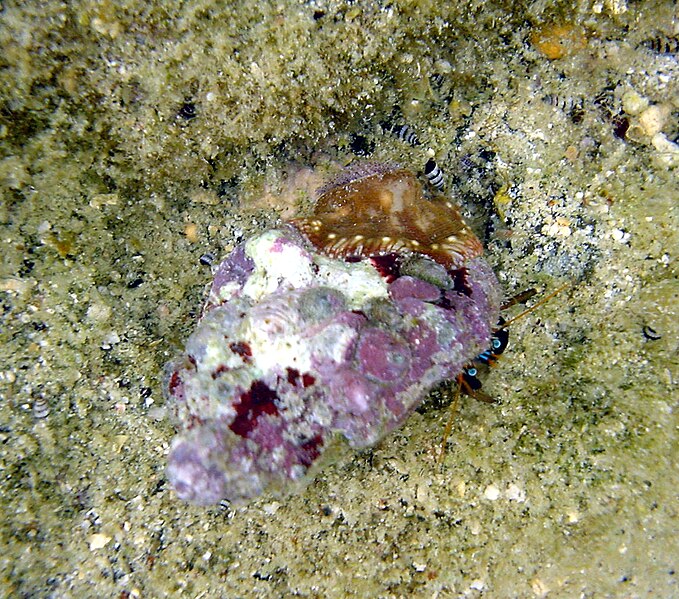
Exploring the role of color in hermit crabs’ defense mechanisms
Color in hermit crabs serves as an important defense mechanism against predators. These crustaceans have the ability to rapidly adjust their coloration to match their surroundings, enabling them to blend in and avoid detection. However, this rapid adjustment of external coloration may be inhibited by the immediate threat of predation.
Hermit crabs have the unique advantage of being able to choose their camouflage independently of their body coloration. This is because they inhabit empty gastropod shells, allowing them to select a shell that matches their surroundings and provides them with effective camouflage.
How hermit crabs use color to deter predators and blend into their environment
One means of predator avoidance is through cryptic coloration, where individuals can rapidly adjust their coloration to match their surroundings. By doing so, hermit crabs can maintain crypticity across a heterogeneous environment. However, predators such as intertidal fishes may still detect color contrast, posing a threat to hermit crabs.
In addition to blending into their environment, hermit crabs also use color displays as a form of threat display. Bright, intense colors are often associated with dominance in social interactions, and these displays can help deter potential predators or competitors.
It is important to note that the intensity and patterns of coloration in hermit crabs can be influenced by various factors. Environmental conditions, social context, and the individual’s physiological state can all play a role in determining the color displays exhibited by these crustaceans.
Understanding the role of color in hermit crabs’ defense mechanisms and camouflage provides valuable insights into their survival strategies. Further research is needed to fully comprehend the mechanisms behind these color displays and their precise significance in different species of hermit crabs.
Overall, hermit crabs utilize color as a means of defense against predators and to blend into their environment. By adjusting their coloration and displaying vibrant hues, hermit crabs can deter predators, establish social bonds, and communicate their social status.
Conclusion
Summary of the vibrant colors displayed by hermit crabs
Color plays a crucial role in the defense mechanisms of hermit crabs. These crustaceans have the ability to rapidly adjust their coloration to blend into their surroundings, providing effective camouflage against predators. They can choose their camouflage independently of their body coloration by inhabiting empty gastropod shells that match their environment. This allows them to maintain crypticity across heterogeneous environments.
In addition to camouflage, hermit crabs also use vibrant colors as a threat display. Bright and intense colors are associated with dominance in social interactions, serving as a deterrent to potential predators or competitors. The intensity and patterns of coloration can be influenced by environmental conditions, social context, and the individual’s physiological state.
Appreciating the beauty and diversity of hermit crab coloration
The use of color in hermit crabs’ defense mechanisms and camouflage highlights their remarkable survival strategies. Their ability to adjust their coloration and display vibrant hues not only helps deter predators but also establishes social bonds and communicates their social status. Exploring the mechanisms behind these color displays and their significance in different species of hermit crabs will provide valuable insights into their behavior and evolution.
The beauty and diversity of hermit crab coloration should be appreciated for its adaptive significance. Further research is needed to fully understand the complex interplay between environmental factors, social dynamics, and physiological state in influencing the color displays exhibited by these crustaceans. By gaining a deeper understanding of hermit crabs’ use of color, we can gain a greater appreciation for the intricate strategies they employ to survive and thrive in their environments.
FAQ: Hermit Crab Color: Exploring the Vibrant Colors Displayed by Hermit Crabs
Q: Why are hermit crabs so colorful?
A: Hermit crabs display vibrant colors for various reasons. One of the main reasons is camouflage, which helps them blend in with their surroundings to avoid predators. Colors also play a role in attracting mates and signaling dominance within their social hierarchy.
Q: What are some common colors seen in hermit crabs?
A: Hermit crabs exhibit a wide array of colors, including shades of red, orange, yellow, blue, green, pink, and purple. These colors can vary between species and even among individual crabs within the same species.
Q: Do hermit crabs change color?
A: Yes, hermit crabs can change color. This color change is typically a response to their environment. For example, if a hermit crab moves to a new shell, it may adjust its color to match the shell’s hue and enhance its camouflage.
Q: Are hermit crabs born with their colorful shells?
A: No, hermit crabs are not born with the colorful shells they are known for. Instead, they acquire these shells as they grow older. They take over abandoned seashells, and over time, algae and other organisms settle on the shell, giving it the vibrant colors we associate with hermit crabs.
Q: Can I determine a hermit crab’s species based on its color?
A: While colors can provide a clue about a hermit crab’s species, it is not always a foolproof method for identification. Other characteristics, such as the shape and size of the crab’s body, legs, and pinchers, as well as its habitat, are also important factors in determining its species.
Q: Are there any specific health concerns related to hermit crab coloration?
A: In general, a hermit crab’s coloration does not indicate any specific health concerns. However, sudden changes in color, such as turning pale or dark, may be a sign of stress, illness, or problems with their habitat. Monitoring the overall well-being of your hermit crab is essential for their health and happiness.
Q: Can I enhance and maintain the color of my hermit crab?
A: While you cannot directly control the color of a hermit crab, providing a healthy and stimulating environment is important. Making sure their habitat has proper lighting, temperature, humidity, and enrichment can help to promote their natural vibrancy. A balanced diet with foods containing carotenoids (such as carrots) may also intensify their colors.
Q: Are there subspecies or variations of hermit crabs known for their unique colors?
A: Yes, there are several subspecies and variations of hermit crabs that exhibit unique coloration. For example, the Ecuadorian hermit crab (Coenobita compressus) is known for its bright purple claws, and the Caribbean hermit crab (Coenobita clypeatus) displays a stunning range of colors, from deep orange to purple.
In conclusion, hermit crabs showcase an incredible diversity of colors, serving both practical purposes, such as camouflage, and social functions like attracting mates. Understanding the reasons behind their striking coloration adds to the fascination of these captivating creatures.
